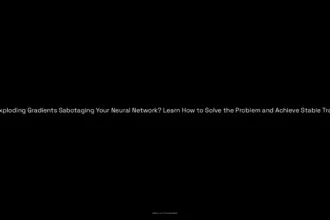Are you tired of sifting through a sea of features, trying to find the ones that truly matter? Look no further, because XGBoost Feature Selection is here to save the day! In this blog post, we’ll dive into the world of XGBoost and explore its powerful feature selection capabilities. From understanding Recursive Feature Elimination to uncovering the role of boosting in feature selection, we’ll leave no stone unturned. But hey, XGBoost isn’t the only player in town! We’ll also take a look at LightGBM, an alternative to XGBoost, and even throw in a comparison between the two. And if that’s not enough, we’ll spice things up with a dash of Random Forest, a bagging model that brings its own unique flavor to the feature selection game. So buckle up and get ready to unleash the power of XGBoost and beyond!
Table of Contents
ToggleXGBoost and Its Feature Selection
Within the realm of data analytics, XGBoost stands as a beacon of efficiency, guiding predictive models with its robust ensemble of decision trees and gradient boosting techniques. It’s not just the algorithm’s predictive prowess that captivates data scientists, but also its innate ability to discern the wheat from the chaff through its feature selection capabilities.
Let’s delve into the heart of XGBoost’s feature selection with its built-in module, plot_importance. This tool doesn’t merely list features; it assigns an f-score to each, quantifying their significance to the model. It’s akin to a compass that steers the model towards the most influential features, ensuring that every variable contributes meaningfully to the predictive power.
| Feature | F-score |
|---|---|
| Feature A | 120 |
| Feature B | 75 |
| Feature C | 30 |
But the utility of plot_importance transcends XGBoost. It’s a guiding light for other models, too, offering a universal yardstick for feature selection. Consider a data scientist, meticulously crafting a model. With XGBoost’s insights, she can refine not only her XGBoost model but also enhance subsequent models, regardless of their architecture.
XGBoost’s feature selection is particularly indispensable when navigating the vast sea of data. It helps to avoid the siren call of overfitting, where models become ensnared by noise and redundancy. In this context, the algorithm is more than a predictive tool; it’s a guardian against the pitfalls that lurk in the depths of complex datasets.
While boosting is often touted for its predictive might, its role in feature selection is sometimes overshadowed. Yet, in truth, boosting serves as a masterful sculptor, chiseling away at the feature space to reveal the most relevant contours for wrapper-based feature selection.
Nonetheless, there are times when the strengths of XGBoost might not align with the task at hand. For instance, in scenarios where interpretability is paramount over raw performance, the dense foliage of numerous trees may obscure the path to understanding. In such cases, simpler models may be preferred.
Moreover, the speed of XGBoost, often heralded as lightning-fast, arises from its use of bagging. It’s like an assembly line of decision trees, each learning in parallel, then uniting their wisdom. This not only accelerates the learning process but also sharpens the algorithm’s acumen when faced with a multitude of features.
As we venture beyond the confines of this section, we’ll explore other facets of feature selection, such as Recursive Feature Elimination and the role of boosting in this nuanced art. But for now, let XGBoost’s feature selection serve as a testament to the algorithm’s multifaceted strength—a strength that lies not only in prediction but also in the crucial prelude of selecting the right features to inform those predictions.
Understanding Recursive Feature Elimination
In the realm of feature selection, the Recursive Feature Elimination (RFE) algorithm emerges as a master sculptor, meticulously chiseling away the excess to unveil the most impactful predictors in a dataset. Imagine a sculptor, not with a hammer and chisel, but equipped with statistical prowess and a keen eye for the essential. RFE operates on a similar principle, engaging in a methodical process of model fitting followed by the strategic exclusion of the least important features.
The compelling narrative of RFE begins with a model that includes all available features. Like an artist assessing their canvas, RFE evaluates the contribution of each feature. However, instead of strokes of paint, it uses coefficients or feature importances to determine which features are merely adding noise rather than clarity to the predictive power of the model. With each iteration, the least significant feature is removed, and the model is refit. This process continues in a loop, akin to a potter shaping and smoothing clay, until the dataset is distilled to include only the most potent and relevant features.
This algorithm shines particularly bright when faced with high-dimensional datasets, where the sheer number of features dwarfs the number of observations. In such scenarios, RFE acts as a beacon of simplicity, guiding data scientists through a labyrinth of potential variables to find the true contributors to their model’s predictive might. It’s a journey of elimination that leads to a destination of clearer insights and more robust performance.
Consider the robustness of RFE in the context of other popular feature selection methods such as Fisher’s Score, Correlation Coefficient, and Random Forest Importance. Each of these has its place in the data scientist’s toolkit, yet RFE distinguishes itself by its recursive nature—continuously refining the model until the desired number of features is left standing, like the last pieces of a puzzle falling into place, revealing the bigger picture.
While there is no one-size-fits-all answer to which feature selection algorithm is the best, RFE stands out for its systematic approach and adaptability. It is akin to the Best-First algorithm, which also searches for a subset of features that maximizes model performance. However, RFE’s iterative refinement can be particularly insightful when a data scientist seeks not just a static set of strong predictors but a deeper understanding of the hierarchy and interplay of features within their model.
When considering gradient boosting models such as XGBoost, feature selection becomes not just a recommendation but a necessity. The precision of RFE can help mitigate the risks of overfitting, unnecessary complexity, and the inclusion of redundant or noisy variables. By stripping away the superfluous, RFE aids in harnessing the full power of gradient boosting, ensuring that every feature included is there because it has earned its place through demonstrable impact on the model’s predictions.
As we navigate through the intricate tapestry of machine learning algorithms, RFE stands as a testament to the elegance of simplicity. It is the quiet but determined force that peels back layers of complexity to reveal the true essence of the data. In the following sections, we will delve into the role of boosting in feature selection and beyond, continuing our exploration of how to craft the most predictive and parsimonious models.
Role of Boosting in Feature Selection
In the quest to unveil the most predictive elements within a sea of data, boosting algorithms like XGBoost stand out as intrepid explorers, charting the course for feature selection with precision and finesse. The essence of boosting’s role in this realm lies in its ability to sculpt the feature landscape, transforming it into a more manageable and insightful form. This intricate process is akin to a master jeweler cutting a raw diamond, revealing the brilliant facets within.
At the heart of boosting’s prowess is its wrapper-based feature selection method, a technique that doesn’t just filter features in isolation but evaluates them in subsets. This approach allows for the discovery of complex interactions between variables, much like how a conductor perceives the interplay of instruments to create a harmonious symphony. By constructing and deconstructing these subsets, boosting algorithms like XGBoost can discern the true contributors to the predictive power of a model.
Unlike filter and embedded methods, which may overlook the subtle yet crucial relationships between variables, boosting algorithms thrive on detection. They dynamically adjust the search space, meticulously sifting through features to find the golden threads that bind the tapestry of data together.
Consider the role of boosting algorithms as a beacon, guiding ships through foggy waters. In feature selection, this beacon illuminates the way, ensuring that each feature is evaluated not just on its own merit but on its contribution to the collective outcome of the model. It’s a dance of algorithmic agility that balances individual significance with cooperative strength.
Thus, while we ponder the question, “Can we use XGBoost for feature selection?” we discover that the answer lies not just in the affirmative but in the revelation of XGBoost’s intrinsic capability to enhance the selection process. Its plot_importance module is a testament to its utility, brandishing the f-score of each feature like a flag that signifies its value on the predictive battlefield.
In the grand scheme of model building, the role of boosting in feature selection emerges as a pivotal force. It is the strategic ally that ensures our models are robust yet refined, powerful yet precise. As we navigate the remainder of our journey through the realm of XGBoost and feature selection, let us carry forward the insights gleaned from the intelligent artistry of boosting algorithms.
Limitations of XGBoost
While XGBoost stands as a towering figure in the landscape of machine learning algorithms, it is not without its Achilles’ heel. Delving into the intricacies of XGBoost, we uncover that it may falter when faced with sparse and unstructured data. This is a realm where traditional models and neural networks might navigate with more agility, leaving XGBoost grappling for patterns in a space where its trees cannot take root.
In the pursuit of accuracy, XGBoost may also stumble upon the stumbling blocks of outliers. These statistical anomalies can drastically tilt the scales of the model’s predictions, painting a skewed picture of the underlying trends. The sequential nature of boosting means that each tree is intricately linked to the corrections of its predecessors, making it sensitive to these deviant data points—akin to building a tower where each level is affected by the slightest tilt of the one below.
Furthermore, when it comes to scaling up, XGBoost reveals a chink in its armor. Its sequential tree building process is a double-edged sword; it ensures the refinement of errors but at the cost of parallel processing. This inherent design choice means that, unlike some of its contemporaries, XGBoost cannot fully exploit the vast computational resources that come with distributed computing environments. This limitation is particularly poignant in an era where big data reigns supreme, and scalability is not just a feature but a necessity.
Despite these limitations, it’s important to recognize that no single algorithm can claim supremacy across all terrains of data. XGBoost, with its ensemble approach and gradient boosting prowess, remains a formidable ally in the quest for predictive precision—provided its limitations are acknowledged and navigated with expertise.
As we continue to unravel the tapestry of feature selection strategies, we will next explore LightGBM, an alternative to XGBoost that promises to address some of these very limitations. This exploration will cast light on the nuances of choosing the right algorithm for the right job, a decision that could mean the difference between a model that soars and one that stumbles.
LightGBM: An Alternative to XGBoost
In the realm of machine learning, the quest for efficiency and precision is never-ending. Enter LightGBM, a gradient boosting framework that propels this quest forward by offering an alternative to the venerable XGBoost. It stands out not just for its speed but for its ability to gracefully manage the complexities of large datasets. Developed with the finesse of C++ programming and the option of GPU acceleration, LightGBM is a paragon of efficiency in the machine learning world.
Imagine a sculptor, chiseling away with precision to create a masterpiece. Similarly, LightGBM carves out its niche with histogram-based split finding, a technique that smartly bins continuous feature values into discrete bins. This reduces memory usage and speeds up the calculation process. Moreover, its distinctive leaf-wise tree growth strategy, which allows for deeper, more refined trees, differs from the traditional level-wise approach, leading to a significant gain in learning efficiency.
Comparison: XGBoost vs. LightGBM
The match-up between XGBoost and LightGBM often boils down to a trade-off between resource consumption and time efficiency. Although both are heavyweights in predictive prowess, LightGBM often sprints ahead in the race against the clock. With its ingenious optimizations, LightGBM can train models in a fraction of the time XGBoost would require, especially when the datasets swell in size.
Consider a professional kitchen where both a seasoned chef and a promising apprentice can whip up a gourmet dish. The end result might be indistinguishably exquisite, but the chef, with years of experience and refined techniques, can achieve the same outcome more swiftly. Likewise, while XGBoost has laid a robust foundation in feature selection and model building, LightGBM’s advanced methodologies enable it to deliver similar results in a more expedient manner, making it a preferred choice for many machine learning practitioners.
As we navigate the intricate landscape of algorithm selection, it’s essential to recognize that the best tool for the job often depends on the specific data challenges and constraints at hand. LightGBM emerges as a compelling alternative to XGBoost, especially when time is of the essence, and the data is voluminous and complex.
Stay tuned as we delve further into the intricacies of these machine learning titans in subsequent sections, providing you with the insight needed to make an informed decision on the right algorithm for your feature selection needs.
Random Forest: A Bagging Model
In the vibrant landscape of machine learning algorithms, where XGBoost shines with its feature selection prowess, there emerges a compelling counterpart known as Random Forest. This bagging model is akin to a robust ensemble of decision trees, each grown in the fertile soil of data and diversity. Unlike the sequential growth of trees in XGBoost, where each one learns from the shadows of its predecessors, Random Forest plants its trees in an expansive forest, allowing them to flourish independently and in parallel. This architectural distinction paves the way for Random Forest to tackle larger datasets with the might of scalability on its side.
Imagine a team of experts, each analyzing a different facet of a complex problem, simultaneously offering their insights. This is the essence of Random Forest. By generating a multitude of decision trees and aggregating their predictions, it embodies the wisdom of the crowd, making it a formidable force against the uncertainties of data. The parallel computation not only enhances performance but also serves as a bulwark against overfitting, a common pitfall in machine learning.
It’s crucial to recognize the strategic advantage of Random Forest when faced with voluminous and diverse datasets. The algorithm’s inherent ability to scale effectively and manage computational complexities grants it a special place in the toolkit of data analysts. Given the right circumstances, its parallel nature can outshine the more sequential approach of XGBoost, offering a beacon of hope for those grappling with the enormity of big data.
Yet, one must tread carefully on the path of algorithm selection, as the terrain of data problems is ever-shifting. While the sturdy structure of Random Forest offers shelter against the storms of large-scale data, XGBoost’s iterative refinement may still hold the key to unlocking deeper insights in certain scenarios. This is particularly true when dealing with streaming data or confronting the challenges posed by class imbalances, where the adaptive nature of XGBoost could potentially yield more nuanced models.
Therefore, navigating the decision of whether to deploy Random Forest or its counterparts like XGBoost or LightGBM requires a keen understanding of their individual strengths. It is a choice that must be informed by the nature of your data, the size of your datasets, and the specific challenges you face. Only by weaving together the threads of knowledge about these powerful algorithms can one craft a tapestry of solutions that are not just effective, but elegantly tailored to the intricacies of the task at hand.
As we continue to delve into the realms of feature selection and machine learning, let us embrace the diversity of algorithms like Random Forest. It stands as a testament to the ingenuity of parallel processing, a beacon for those navigating the vast oceans of data in search of the lighthouse of insight.
Q: Can you use Xgboost for feature selection?
A: Yes, XGBoost provides a module called plot_importance which gives the f-score of each feature, indicating its importance to the model. This can be helpful for selecting features not only for XGBoost but also for similar models.
Q: Is feature selection necessary for gradient boosting?
A: Yes, feature selection is necessary for gradient boosting to avoid overfitting, noise, and redundancy. While gradient boosting is a powerful algorithm, careful feature selection is required to improve accuracy and performance.
Q: Do you need feature selection for gradient boosting?
A: The internal feature selection of gradient-boosted trees, which selects the best splits during tree construction, is often sufficient. However, if you have a large number of non-informative features, searching through these features may be a waste of time.
Q: What is XGBoost and how does it work?
A: XGBoost is a machine learning algorithm that uses an ensemble of decision trees and gradient boosting to make predictions. It has gained popularity in data science and has won several machine learning competitions.
Q: Does boosting do feature selection?
A: Yes, boosting, which is a popular meta-algorithm in ensemble classification, can also be used to modify the feature search space in wrapper-based feature selection.
Q: Where should XGBoost not be used?
A: There is no specific information provided about where XGBoost should not be used in the given facts.





